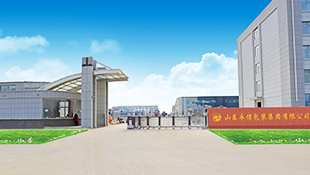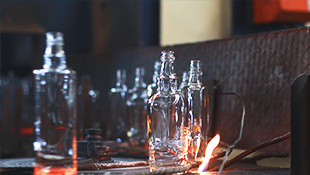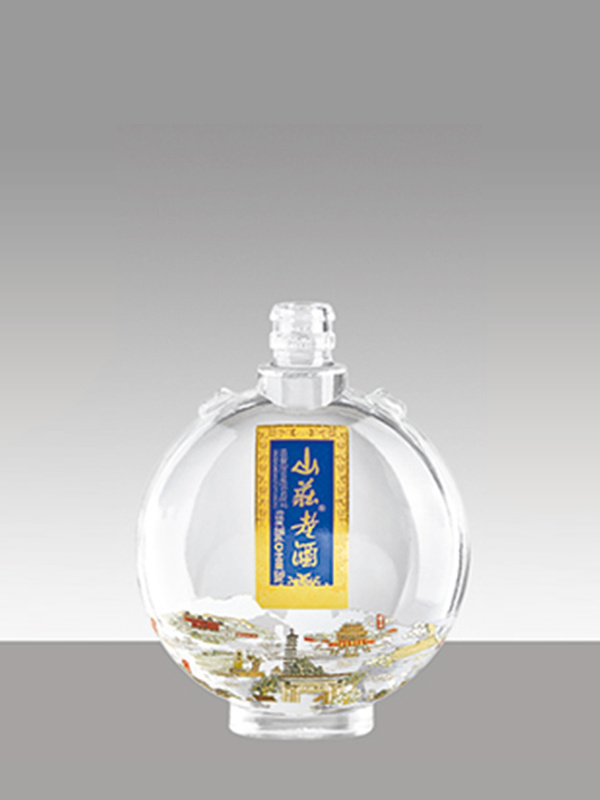500ml
Key words:
Detailed Description
A wine bottle is a container used to hold wine.
Historically, wine bottles were mostly presented to the world in a simple style of "soy sauce bottle", glass material, less information, and no heavy decoration. In the earlier stage, China's glass production technology was backward, and glass bottles were basically imported and were "imported", so the early glass bottles were commonly known as "foreign sticks". Even the common saying still refers to a bottle of wine as a bar of wine.
Since the reform and opening up, the once dismissive wine bottle has sprung up and been looked at differently. Wine bottles are becoming more and more colorful, and there is a prosperous scene of flowers, including glass wine bottles, plastic wine bottles, ceramic wine bottles, etc., and ceramic wine bottles are very popular. And as a cultural landscape, boarded the hall of elegance, become an important part of wine culture. If the traditional folk wine bottles in the past paid more attention to daily use and practicality, then the modern wine bottles added more artistic, ideological and scientific. Modern wine bottle is rich in connotation, which has gone beyond the concept of wine container only, and has become a unique carrier of packaging art and elegant culture.
The requirement for wine bottles is not to introduce other odors in long-term storage, not to introduce other ingredients that are not conducive to health, to minimize the loss of wine, and a small amount of wine with exhaust requirements.
Alcohol is a solvent, for lead, aluminum and other metals reaction ability is strong, so should try to avoid the introduction of these substances, the use of lead-free glass and lead-free ceramics.
Materials
Raw materials and chemical composition
The bottle glass compound is generally composed of 7 to 12 kinds of raw materials. Mainly quartz sand, soda ash, limestone, dolomite, feldspar, borax, lead and barium compounds. In addition, there are auxiliary materials such as clarifying agents, colorants, decolorizing agents, and opacifiers (see glass manufacturing). Coarse particles of quartz is difficult to melt completely; particles are too fine in the melting process and easy to produce dross and dust, affecting the melting, easy to block the melting furnace heat storage chamber. The suitable particle size is 0.25~0.5mm. In order to make use of waste glass, broken glass is usually added, and its amount is usually 20-60%, up to 90%.
The chemical composition of glass bottles and jars varies according to their use requirements, molding methods, molding speed, process characteristics and raw material varieties. Most bottles are made of soda-lime-silicate glass. The main components of soda lime silicate glass are SiO2, Na2O and CaO. The introduction of appropriate amount of Al2O3 and MgO can reduce the crystallization tendency of glass, enhance the chemical stability and mechanical strength of glass, and improve the formability of glass. The chemical composition of soda-lime bottle glass in most countries in the world is: SiO270 ~ 74%,CaO and MgO10 ~ 14%,Na2O and K2O13 ~ 16%,Al2O31.5 ~ 2.5%. When making colorless glass bottles, the content of Fe2O3 in quartz sand is very low (generally about 0.03%). In ordinary soda-lime glass, adding Cr2O3 and Fe2O3, the glass is emerald green, adding sulfur-carbon or MnO2 and Fe2O3, the glass is brown.
The main features of glass packaging containers are: non-toxic, tasteless; transparent, beautiful, good barrier, airtight, rich and common raw materials, low price, and can be used many times. And it has the advantages of heat resistance, pressure resistance and cleaning resistance, which can be sterilized at high temperature and stored at low temperature. Because of its many advantages, it has become the packaging material of beer, fruit tea, jujube juice and many other beverages.
71% of the world's beer is filled in glass beer bottles, and China is also a country with a high proportion of glass beer bottles in the world, accounting for 55% of the world's glass beer bottles, with more than 50 billion glass beer bottles every year. As the mainstream packaging of beer packaging, glass beer bottles have gone through a hundred years of vicissitudes of beer packaging, and are still favored by the beer industry for their stable material structure, no pollution and low price, when the enterprise wants the packaging to have a beautiful appearance, at the same time can give people a cold touch. In general, glass bottles are still the usual packaging for beer companies." It has made a great contribution to beer packaging, and most people like to use it.
Quality Standards
Glass bottles and jars should have certain performance and meet certain quality standards.
① Glass quality: pure and uniform, no sand, stripes, bubbles and other defects. Colorless glass has high transparency; the color of the color glass is uniform and stable, and can absorb light energy of a certain wavelength.
Physical and chemical properties: It has certain chemical stability and does not interact with the contents. Has a certain degree of shock resistance and mechanical strength, can withstand washing, sterilization and other heating, cooling process and withstand filling, storage and transportation, encounter general internal and external stress, vibration, impact, can remain intact.
③ Molding quality: maintain a certain capacity, weight and shape, uniform wall thickness, smooth and smooth mouth to ensure convenient filling and good sealing. No skew deformation, surface is not smooth, uneven and cracks and other defects.
Manufacturing process Glass bottles and jars manufacturing mainly includes the preparation of materials, melting, molding, annealing, surface treatment and processing, inspection and packaging and other processes.
① Preparation of batch materials: including storage, weighing, mixing and transportation of raw materials. The mixture is required to be evenly mixed and the chemical composition is stable.
② Melting: The melting of bottles and cans of glass is mostly carried out in a continuous operation type flame pool kiln (see glass melting furnace). The daily output of the horizontal flame tank kiln is generally more than 200t, and the large one is 400~500t. The daily output of the horseshoe flame tank kiln is mostly below 200t. The melting temperature of glass is as high as 1580~1600 ℃. The energy consumption of melting accounts for about 70% of the total energy consumption in production. Energy can be effectively saved through measures such as comprehensive insulation of the pool kiln, increasing the capacity of the lattice brick of the regenerator, improving the distribution of the material pile, improving the combustion efficiency and controlling the convection of glass liquid. Bubbling in the melting pool can improve the convection of glass liquid, strengthen the process of clarification and homogenization, and increase the amount of material. The use of electric heating in the flame kiln can increase the output and improve the quality without increasing the melting furnace.
③ Molding: mainly using the molding method, the application of blowing-blowing molding small mouth bottle, pressure-blowing molding wide mouth bottle (see glass manufacturing). Less regulated. The production of modern glass bottles and jars is widely used in automatic bottle making machine high-speed molding. This kind of bottle making machine has certain requirements on the weight, shape and uniformity of the drops, so the temperature in the feeding tank must be strictly controlled. There are many types of automatic bottle making machines, among which determinant bottle making machines are commonly used. This kind of bottle making machine material drop obeys the bottle making machine, not the bottle making machine obeys the material drop, so there is no rotating part, the operation is reliable, and any branch can stop separately for maintenance without affecting the operation of other branches (fig. 1). The determinant bottle making machine has a wide range of manufacturing bottles and cans, and has been developed into 12 groups, double-drop or three-drop forming and microcomputer control.
④ Annealing: Annealing of glass bottles is to reduce the permanent stress of glass residue to the allowable value. Annealing is usually carried out in a continuous annealing furnace of mesh belt type, and the annealing temperature is about 550~600 ℃. The mesh belt annealing furnace (Fig. 2) adopts forced air circulation heating to make the temperature distribution of the furnace cross-section consistent and form an air curtain, restrict the longitudinal air movement, and ensure the uniform and stable temperature of each zone in the furnace.
⑤ Surface treatment and processing: Generally, the surface treatment of glass bottles is carried out by coating the hot end and cold end of the annealing furnace. The hot end coating is to place the bottles and cans in the hot state (500~600 ℃) after molding in the environment of gasified tin tetrachloride, titanium tetrachloride or tin tetrachloride butyl ester, so that these metal compounds are decomposed and oxidized into oxide films on the surface of the hot bottles and cans to fill in the micro cracks on the glass surface, prevent the generation of micro cracks on the surface, and improve the mechanical strength of the glass bottles and cans. Cold end coating is a single stearate, oleic acid, polyethylene emulsion, silicone or silane, etc., in the annealing furnace outlet of the temperature of about 100~150 ℃ on the surface of the bottle can be sprayed to form a layer of lubricating film, in order to improve the wear resistance, lubricity and impact strength of the bottle surface. In production, cold end coatings are often used in combination with hot end coatings. For large-capacity bottles and cans above 1l, some are sheathed with foamed polystyrene or polyethylene film on their surfaces. The sheath has heat shrinkage, which tightens the bottle body after heating, is tough and elastic, shockproof and anti-friction, and no fragments burst when the bottle is broken, thus avoiding personal injury.
Reagent bottles, sample bottles and perfume bottles equipped with glass plugs shall be ground and plugged with mortar or carborundum and water as abrasive. Cosmetics and perfume bottles are often ground and polished to eliminate mold marks and increase luster. Wine bottles or art decoration bottles with hydrofluoric acid corrosion, resulting in surface light diffusion, feel delicate. In order to print trademarks and decorations on the glass surface, the glass glaze is applied to the surface of bottles and cans by spray color, screen printing and decal processing methods, and baked at 600 ℃. The glaze is fused with the glass to form a permanent pattern. If organic pigments are used for decoration, it only needs to be melted and baked at 200~300 ℃.
⑥ Inspection: find out defective products and ensure the quality of products. The defects of glass bottles and cans are divided into two categories: defects of glass itself and defects of bottle forming. The former includes bubbles, stones, stripes and color irregularities; the latter is cracks, uneven thickness, deformation, cold spots, wrinkles, etc. In addition, check the bottle weight, capacity, bottle mouth and body size tolerance, internal stress resistance, thermal shock resistance and stress relief. Beer bottles, beverage and food bottles, etc. cannot be adapted by visual inspection due to their high production speed and large batches. There are now automatic inspection equipment, such as preselectors (check the shape and dimensional tolerances of bottles and cans), bottle mouth checkers, crack checkers, wall thickness checking devices, extrusion testers, pressure testers, etc.
⑦ Packaging: corrugated cardboard box packaging, plastic box packaging and pallet packaging. All have been automated. Corrugated cardboard box packaging from empty bottle packaging until filling, sales, all use the same carton. The plastic box used for plastic box packaging can be recycled and reused. Tray package packaging is to arrange the bottles that have passed the inspection into a rectangular bottle array, move them to the tray and stack them layer by layer, and wrap them up to the specified number of layers. Generally, it is also covered with a plastic film sleeve, heated to shrink it, tightly wrapped into a strong whole, and then bundled. This is also called thermoplastic packaging.
Process flow
The production process of glass bottles mainly includes: ① pre-processing of raw materials. The massive raw materials (quartz sand, soda ash, limestone, feldspar, etc.) are crushed, the wet raw materials are dried, and the iron-containing raw materials are removed from iron to ensure the quality of the glass. ② Preparation of batch materials. ③ Melting. The glass batch is heated at high temperature (1550~1600 degrees) in the pool kiln or pool furnace to form a uniform, bubble-free liquid glass that meets the molding requirements. ④ Forming. Put the liquid glass into the mold to make the required shape of the glass products, such as flat plates, various utensils, etc. ⑤ Heat treatment. Through annealing, quenching and other processes, the internal stress, phase separation or crystallization of the glass is eliminated or generated, and the structural state of the glass is changed.
Domain Benefits
Advantages of glass packaging containers in the field of beverage packaging
Glass packaging materials and containers have many advantages:
1. The glass material has good barrier properties, which can well prevent the invasion of oxygen and other gases to the contents, and at the same time prevent the volatile components of the contents from volatilizing into the atmosphere;
Glass bottles can be used repeatedly, which can reduce packaging costs;
Glass can be easily changed in color and transparency;
4, glass bottle reliable health, good corrosion resistance and acid corrosion resistance, suitable for acidic substances (such as fruit and vegetable juice drinks, etc.) packaging;
In addition, because the glass bottle is suitable for the production of automatic filling production line, the domestic glass bottle automatic filling technology and equipment development is also more mature, the use of glass bottle packaging fruit and vegetable juice beverages in the domestic production advantages.









